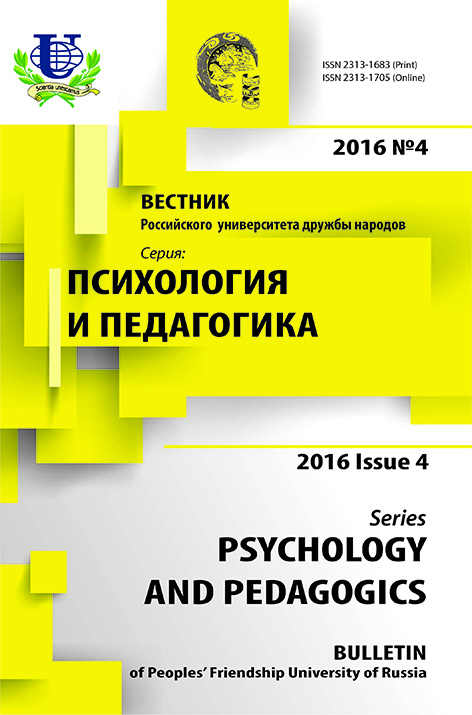№ 4 (2016)
- Год: 2016
- Статей: 9
- URL: https://journals.rudn.ru/psychology-pedagogics/issue/view/913
- DOI: https://doi.org/10.22363/2313-1683-2016-4
Весь выпуск
Статьи
КРЕАТИВНОСТЬ И КОНВЕРГЕНТНОЕ МЫШЛЕНИЕ: ОТРАЖЕНИЯ, СООТНОШЕНИЯ И ПРАКТИЧЕСКИЕ ПРИЛОЖЕНИЯ
Аннотация
Креативность понимается как способность генерировать новые, оригинальные идеи, которые имеют смысл и ценность в их контексте. Теоретики часто обсуждают роль дивергентного и конвергентного мышления в развитии и функционировании креативности. В данной статье внимание сосредоточено на конвергентном мышлении и способах его концептуализации и операционализации. Установлено, что некоторые из рассматриваемых концепций в большей степени соответствуют пониманию креативности. Представлены и обоснованы некоторые новые способы диагностики конвергентного мышления, которые могут быть использованы для измерения креативности. В частности, описана тестовая батарея «Оценка потенциала креативности» (EpoC), являющаяся новым релевантным инструментом для оценки конвергентного мышления с акцентом на интегративный и оригинальный синтез, который является самым существенным для креативных процессов и обеспечивает возможности для генерации творческих продуктов. Обсуждаются практические приложения данной проблемы в сфере психодиагностики креативности и в образовании.
 7-15
7-15


ВВЕДЕНИЕ ПРОГРАММЫ БИЛИНГВАЛЬНОГО И ТВОРЧЕСКОГО ОБРАЗОВАНИЯ В УЧЕБНЫЙ ПЛАН РОССИЙСКИХ ШКОЛ
Аннотация
В данной статье представлена проблема, широко обсуждаемая как в исследованиях билингвизма, так и в исследованиях творческих процессов, рассматриваемая с точки зрения ее педагогических приложений. Исследования, проведенные автором в последние десятилетия, убедительно доказывают, что владение более чем одним языком способствует развитию творческих способностей человека. Автор расширил сферу своих исследований и применил их результаты в области образования. Предлагаемый авторский новый подход объединяет стратегии обучения, используемые в обеих областях (билингвизм и творчество), в единой программе билингвального и творческого образования. Целью программы является преподавание дисциплин на двух языках и развитие творческого потенциала школьников. Для достижения этой цели программа использует комплексный подход, который объединяет когнитивные, личностные и средовые факторы образования. В статье обсуждается данный подход и предлагаются направления для реализации предлагаемой программы в России.
 16-28
16-28


ЗАДАТКИ, ВОЗМОЖНОСТИ И СПОСОБНОСТИ: ИНТЕГРАЦИЯ ПОДХОДОВ К ИССЛЕДОВАНИЮ ТВОРЧЕСКИХ ПРОЦЕССОВ У ЧЕЛОВЕКА И ЖИВОТНЫХ
Аннотация
При всех различиях в изучении творческих и инновационных процессов у животных и человека существует и определенное сходство, которое можно лучше понять при интеграции обоих подходов. Оба подхода направлены на изучение творческих способностей, но исследователи животных предпочитают концепцию творческих задатков, а исследователи человека - творческого потенциала. В статье рассмотрены следствия, вытекающие из различий в исследовательских подходах, а также то, чем данные подходы могут обогатить друг друга.На основании обзора литературы по проблеме исследования творческих процессов у человека и животных выявлены основные положения, которые позволяют исследователям человека показать путь от возможностей (потенциала) к способностям, а исследователям животных - от задатков к способностям. Исследователи животных уже рассматривают индивидуальные различия между ними и, как результат, показывают, как возможности могут опосредовать связь между задатками и способностями. Если работа в этом направлении будет продолжена, то может быть выявлено то, каким образом индивидуальные различия связаны с высокими творческими и инновационными проявлениями.
 29-36
29-36


САМОРЕГУЛЯТИВНЫЕ СПОСОБНОСТИ ЧЕЛОВЕКА В ПРОФЕССИОНАЛЬНОЙ ДЕЯТЕЛЬНОСТИ
Аннотация
 37-46
37-46


ОСОБЕННОСТИ ОТВЕТСТВЕННОСТИ СТАРШЕКЛАССНИКОВ ИЗ ОДНОДЕТНЫХ И МНОГОДЕТНЫХ СЕМЕЙ
Аннотация
 47-54
47-54


ЭМОЦИОНАЛЬНЫЙ ИНТЕЛЛЕКТ И СТИЛЬ ВОСПИТАНИЯ ДЕВОЧЕК СТАРШЕГО ПОДРОСТКОВОГО ВОЗРАСТА
Аннотация
 55-66
55-66


АВТО- И ГЕТЕРОСТЕРЕОТИПЫ КАК ПОКАЗАТЕЛИ СТЕПЕНИ ВЫРАЖЕННОСТИ ЭМОЦИОНАЛЬНОГО КОМПОНЕНТА ЭТНИЧЕСКОЙ ИДЕНТИЧНОСТИ МЛАДШИХ ШКОЛЬНИКОВ
Аннотация
 67-79
67-79


ПСИХОЛОГИЧЕСКОЕ БЛАГОПОЛУЧИЕ В КОНТЕКСТЕ ПРЕДСТАВЛЕНИЙ СТУДЕНТОВ О ВЫСОКОМ СОЦИАЛЬНОМ СТАТУСЕ
Аннотация
 80-87
80-87


КОНТЕКСТНО-ЭМПИРИЧЕСКИЙ ПОДХОД В ФОРМИРОВАНИИ МАТЕМАТИЧЕСКОЙ КОМПЕТЕНТНОСТИ ОБУЧАЮЩИХСЯ ГУМАНИТАРНЫХ НАПРАВЛЕНИЙ ПОДГОТОВКИ В ВУЗЕ
Аннотация
 88-97
88-97
















